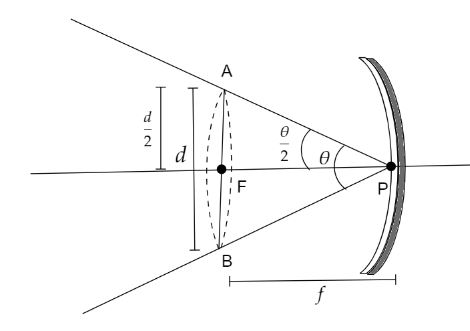
Answer
360.9k+ views
Hint: We have to first draw a diagram of the problem given. By using the concept that when an object is placed at infinity from the surface of a mirror the image forms at the focus of the mirror, we will find the construction of the diagram. Then by using trigonometric concepts we will find the answer.
Complete answer:

The Sun is at infinity which is the object. When an object is at infinity, the image formed due to a concave mirror after reflection from it is at the focus.The pole of the mirror is given as P and the focus as F. Let $d$ be the diameter of the image of the Sun.In the given, the radius of curvature $r = 15{\text{ }}m$
Let the focal length of the mirror be $f$.The relation between radius of curvature $r$ and focal length $f$ is $f = \dfrac{r}{2}$.
So, the focal length $f$ of the mirror$ = \dfrac{{15}}{2} = 7.5{\text{ }}m$
As per the given question, the sun is subtending ${\dfrac{1}{2}^ \circ }$ at the pole.
So, $\dfrac{\theta }{2} = {\dfrac{1}{2}^ \circ } - - - - - \left( 1 \right)$
Converting the given angle in radian we get,
${\dfrac{1}{2}^ \circ } = \dfrac{\pi }{{180}} \times \dfrac{1}{2} = \dfrac{\pi }{{360}}$ radian$ - - - - - \left( 2 \right)$
Now, from the given triangle AFP we get,
$\tan \dfrac{\theta }{2} = \dfrac{{AF}}{{FP}} = \dfrac{{\dfrac{d}{2}}}{f}$
Now, as $\tan \dfrac{\theta }{2}$ is very small, so we consider $\tan \dfrac{\theta }{2} = \dfrac{\theta }{2}$
Hence, we get,
$\dfrac{\theta }{2} = \dfrac{d}{{2f}}$
From$\left( 1 \right)$we get,
${\dfrac{1}{2}^ \circ } = \dfrac{d}{{2f}}$
Again, from $\left( 2 \right)$ we get,
$\dfrac{\pi }{{360}} = \dfrac{d}{{2f}}$
Substituting the value of $f$ we get,
$\dfrac{\pi }{{360}} = \dfrac{d}{{2 \times 7.5}} = \dfrac{d}{{15}}$
$ \therefore d = \dfrac{{22}}{{7 \times 24}} = 0.131$
The diameter of the image of the Sun$ = 0.131{\text{ }}m = 13.1{\text{ }}cm$
Therefore, the correct option is D.
Note: It must be noted that when an object is placed at infinity to a concave mirror the image will always form at the focus of the mirror. The ray of the light is normally considered to be parallel as it comes from infinity. When the angle subtended is very small, then we can omit the trigonometric identity as the difference in value is almost the same.
Complete answer:

The Sun is at infinity which is the object. When an object is at infinity, the image formed due to a concave mirror after reflection from it is at the focus.The pole of the mirror is given as P and the focus as F. Let $d$ be the diameter of the image of the Sun.In the given, the radius of curvature $r = 15{\text{ }}m$
Let the focal length of the mirror be $f$.The relation between radius of curvature $r$ and focal length $f$ is $f = \dfrac{r}{2}$.
So, the focal length $f$ of the mirror$ = \dfrac{{15}}{2} = 7.5{\text{ }}m$
As per the given question, the sun is subtending ${\dfrac{1}{2}^ \circ }$ at the pole.
So, $\dfrac{\theta }{2} = {\dfrac{1}{2}^ \circ } - - - - - \left( 1 \right)$
Converting the given angle in radian we get,
${\dfrac{1}{2}^ \circ } = \dfrac{\pi }{{180}} \times \dfrac{1}{2} = \dfrac{\pi }{{360}}$ radian$ - - - - - \left( 2 \right)$
Now, from the given triangle AFP we get,
$\tan \dfrac{\theta }{2} = \dfrac{{AF}}{{FP}} = \dfrac{{\dfrac{d}{2}}}{f}$
Now, as $\tan \dfrac{\theta }{2}$ is very small, so we consider $\tan \dfrac{\theta }{2} = \dfrac{\theta }{2}$
Hence, we get,
$\dfrac{\theta }{2} = \dfrac{d}{{2f}}$
From$\left( 1 \right)$we get,
${\dfrac{1}{2}^ \circ } = \dfrac{d}{{2f}}$
Again, from $\left( 2 \right)$ we get,
$\dfrac{\pi }{{360}} = \dfrac{d}{{2f}}$
Substituting the value of $f$ we get,
$\dfrac{\pi }{{360}} = \dfrac{d}{{2 \times 7.5}} = \dfrac{d}{{15}}$
$ \therefore d = \dfrac{{22}}{{7 \times 24}} = 0.131$
The diameter of the image of the Sun$ = 0.131{\text{ }}m = 13.1{\text{ }}cm$
Therefore, the correct option is D.
Note: It must be noted that when an object is placed at infinity to a concave mirror the image will always form at the focus of the mirror. The ray of the light is normally considered to be parallel as it comes from infinity. When the angle subtended is very small, then we can omit the trigonometric identity as the difference in value is almost the same.
Recently Updated Pages
Who among the following was the religious guru of class 7 social science CBSE

what is the correct chronological order of the following class 10 social science CBSE

Which of the following was not the actual cause for class 10 social science CBSE

Which of the following statements is not correct A class 10 social science CBSE

Which of the following leaders was not present in the class 10 social science CBSE

Garampani Sanctuary is located at A Diphu Assam B Gangtok class 10 social science CBSE

Trending doubts
A rainbow has circular shape because A The earth is class 11 physics CBSE

Fill the blanks with the suitable prepositions 1 The class 9 english CBSE

Which are the Top 10 Largest Countries of the World?

How do you graph the function fx 4x class 9 maths CBSE

The Equation xxx + 2 is Satisfied when x is Equal to Class 10 Maths

Give 10 examples for herbs , shrubs , climbers , creepers

Change the following sentences into negative and interrogative class 10 english CBSE

Difference between Prokaryotic cell and Eukaryotic class 11 biology CBSE

Why is there a time difference of about 5 hours between class 10 social science CBSE




